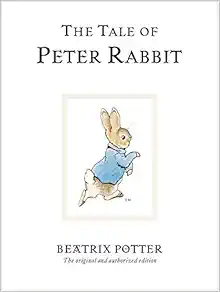Plagiarism doesn’t count, when the plagiarist and the person copied, are both dead, I guess. I’ve been reading The Adventures of Peter Cottontail by Thornton W. Burgess, to my grandchildren. I happened to mention this to a friend who asked me, “Didn’t Beatrix Potter write Peter Rabbit?”
Yes, she did.
Who copied whom?
I googled Thornton Burgess.
He lived from 1874 to 1964.
Beatrix Potter lived from 1866 to 1943.
So they lived around the same time. Beatrix was English. Thornton was American; in fact, from
Massachusetts.
Beatrix wrote The Tale
of Peter Rabbit in 1902.
Thornton wrote the Adventures
of Peter Cottontail in 1914.
Beatrix wrote about nature and Peter’s rabbit friends,
Mopsy, Flopsy, and Cotton-tail.
Thornton wrote about nature too, and his Peter’s friends
were Reddy Fox, Shadow the Weasel, Johnny Chuck, Billy Possum, and they all
lived in the Green Forest, the Green Meadows, and the Smiling Pool narrated by
Old Mother West Wind.
By the time Thornton’s little boy was old enough to read to,
Thornton read him Beatrix Potter’s The
Tale of Peter Rabbit. A few years
later when Thornton tried to make up a bed time story for his son, he changed
the name of the rabbit to Cottontail.
The four year old wouldn’t let his father change the name. In fact, the argument over the name is the
first chapter in The Adventures of Peter
Cottontail. Peter Rabbit thought his
name too common, so he changed it to Peter Cottontail. But then it proved to be confusing.
Thornton wasn’t the only plagiarist capitalizing on the
Peter Rabbit theme. The illustrator,
Harrison Cady, wrote a comic strip from 1920-1948, called Peter Rabbit.
In 1950, Gene Autry recorded the song, “Here Comes Peter Cottontail.”
The 1971 Easter television special “Here Comes Peter
Cottontail” was based on a 1957 novel by Priscilla and Otto Friedrich entitled “The
Easter Bunny that Overslept.”
But back to Thornton Burgess
because he’s from our neck of the woods.
He wrote his nature stories for over 50 years. Some call him the Bedtime Story-man. He was born in Sandwich, MA and stayed in MA
all his life. Today, the Thornton W.
Burgess Society continues to carry out the philosophies of Thornton Burgess’
stories. The society operates the Green
Briar Nature Center and Thornton W. Burgess Museum in Sandwich, MA and
publishes periodic newsletters to inspire reverence for wildlife and concern
for the natural environment.
By the time Thornton retired, he had written
more than 170 books and 15,000 stories for daily columns in newspapers.
Thornton Waldo Burgess was the son of Caroline
F. Haywood and Thornton W. Burgess Sr. a direct descendent of Thomas Burgess,
one of the first settlers of Sandwich in 1637.
Burgess was raised by his mother in Sandwich
after his father died in the year of his birth. As a youth he worked year round
in order to earn money. Some of his jobs included tending cows, picking arbutus
or berries, shipping water lilies from local ponds, selling candy and trapping
muskrats. William C. Chipman, one of his employers, lived on Discovery Hill
Road a wildlife habitat of woodland and wetland. This habitat became the
setting of so many of his stories in which he refers to Smiling Pool and the
Old Briar Patch.
Graduating from Sandwich High School in 1891,
Burgess attended a Business College in Boston from 1892-93. At the age of 17
Burgess briefly lived in Boston and then moved to Springfield, Massachusetts.
He bought a place in Hampden, Massachusetts in 1925 and made it his permanent
home in 1957. Returning frequently to Sandwich, Burgess claimed that to be his
birth place and spiritual home. Many of his childhood experiences and the
people he knew influenced his interest and concern for wildlife.
For the next fifty years, Burgess steadily
wrote books that were published around the world in many languages, including
Swedish, French, German, Spanish, Italian, and Gaelic. Collaborating with him
was his illustrator and friend, Harrison Cady of New York and Rockport,
Massachusetts. Cady gave us the familiar form of Peter Rabbit and other animal
characters that we recognize today in his comic strip.
Burgess was also actively involved with
conservation efforts. Some of his projects over his lifetime included:
·
"The Green Meadow
Club" for land conservation programs,
·
Help pass laws
protecting migrant wildlife,
·
The Bedtime Stories
Club" for wildlife protection programs,
·
"Happy Jack
Squirrel Saving Club" for War Savings Stamps & Bonds,
·
"The Radio Nature
League" broadcast from WBZA Springfield, MA.
For his efforts, an Honorary Literary Degree
was bestowed upon Burgess in 1938 from Northeastern University. The Boston
Museum of Science awarded him a special gold medal for "leading children
down the path to the wide wonderful world of the outdoors." He was also
awarded the distinguished Service Medal of the Permanent Wildlife Protection
Fund.
In 1960, Burgess published his last book,
"Now I Remember," an autobiography depicting memories of his early
life in Sandwich, as well as his career highlights. That same year, Burgess at
the age of 83, had published his 15,000th story. From 1912 to 1960, without
interruption, Burgess wrote a syndicated daily newspaper column titled
"Bedtime Stories."
The society operates the Green Briar Nature Center which is 15 minutes from the Bourne Bridge in Sandwich, MA. On 6 Discovery Road, East Sandwich.





No comments:
Post a Comment